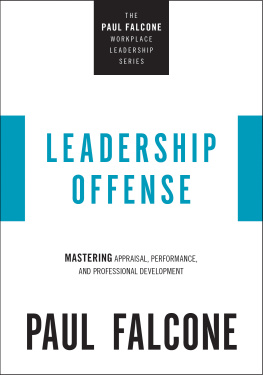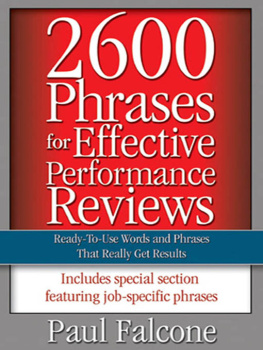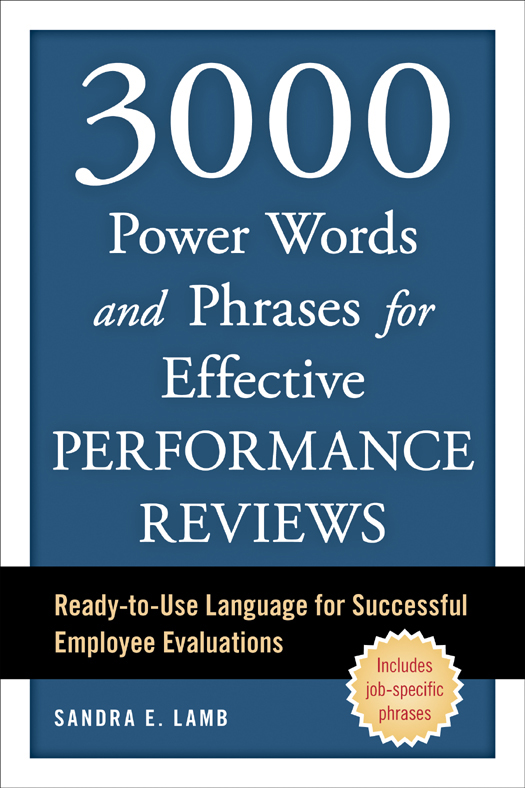3000
Power Words
and Phrases for
Effective
PERFORMANCE
REVIEWS
Ready-to-Use Language for Successful Employee Evaluations
SANDRA E. LAMB
Copyright 2013 by Sandra E. Lamb
All rights reserved.
Published in the United States by Ten Speed Press, an imprint of the Crown Publishing Group, a division of Random House, Inc., New York.
www.crownpublishing.com
www.tenspeed.com
Ten Speed Press and the Ten Speed Press colophon are registered trademarks of Random House, Inc.
Library of Congress Cataloging-in-Publication Data Lamb, Sandra E.
3,000 power words, phrases, and sentences for effective performance reviews /
by Sandra E. Lamb. First edition.
pages cm
Includes index.
1. EmployeesRating of. 2. EmployeesRating ofTerminology. I. Title.
HF5549.5.R3L34 2013
658.3125014dc23
2013017501
Trade Paperback ISBN: 978-1-60774-482-5
eBook ISBN: 978-1-60774-483-2
Design by Colleen Cain
v3.1
Contents
Manufacturing Supervisor
Marketing, Advertising, and Public Relations
The difference between the almost right word
and the right word
is the difference between the lightning bug
and the lightning.
SAMUEL CLEMENS
INTRODUCTION
The Value of Power Words
Amy (lets call her) has an office next to the corner office, which is occupied by her boss, whom well call Ted. Both Ted and Amy have been in these offices for three years. The two share a common wall; and they frequently overhear telephone conversations the other is having while negotiating with a client or coworker.
Ted and Amy go to all the same product release and sales meetings. They see each other in the elevator and break room; and sometimes they casually chat about upcoming holidays, how Teds children are doing in school, or the general state of the national and international economies.
Ted likes Amy and feels that shes doing a good job as district sales manager. The strange thing here is that Ted has, for the entire three years hes been Amys boss, communicated with her for work assignments, updates, progress reports, general information, and even for her performance reviews, entirely by email. He has not conducted a single face-to-face encounter to discuss how she is performing in her role as district sales manager. In short, Ted is clueless about his role as supervisor.
Clearly, Ted either feels entirely unqualified to conduct a face-to-face meeting, or he suffers from a fear of confrontationor both. He seems to feel that doing an in-person performance review, or directly discussing other situations with Amy, offers the possibility that an unpleasant confrontation could occur. She could disagree with his assessment. She could challenge him. So Ted avoids such encounters.
While Ted is meeting his own personal goal of avoiding a possible confrontation, he is not meeting his responsibility as a supervisor/manager. Privately, he admits that he was unprepared for this role, and its one hes not comfortable in. Avoiding a face-to-face meeting with Amy is his way of trying to dodge this part of his job.
But he is doing Amy, and their company, a severe disservice.
The result of Teds failure to have a face-to-face review is that Amy doesnt feel she has any real connection to Ted, nor does she feel a sense that they are teammates working together to achieve common corporate goals. In fact, the absence of this vital part of the review process has meant that Amy hasnt gotten the feedback she needs to perform at her full potential, nor has she gotten vital input that would help her set her future career goals. She doesnt know how shes performing in her sales manager role within the organization as a whole.
Hopefully, Ted will buy a copy of this book. And when he follows the simple steps in these pages, he will be able to easily overcome his fear of conducting meetings with Amy. This book will give him the toolsthe exact power wordsto do his job of manager efficiently and expertly.
It will help Amy, too. Following the simple steps in this book will mean that Ted, Amy, and their organization will all perform at a much higher level.
SECTION ONE
Rethink Traditional Annual Performance Reviews
THE DEBATE STILL RAGES: does the annual performance review offer real value, or does it alienate employees from their managers? The answer is, of course, it all depends. Survey results indicate that the once-a-year review, when used as the only performance measurement tool, fails miserably to make lasting performance improvements. But when it is part of an overall performance improvement program, it can be very effective.
The proper framework for all performance reviews is that the employee and manager first focus on the big-picture objectives: (1) increasing customer benefits and satisfaction; (2) adding value to the organization; and (3) contributing to the efforts of the team or coworkers.
For any performance system to work at its best, the relationship between manager and employee needs to be one of mutual respect, support, and collaboration. Rather than being a disciplinarian, the manager needs to be a performance coach. Then, of course, theres the issue of timing. The function of performance coach works best when done on an ongoing basisdaily, once a week, biweekly, or once a month. This approach means that whenever the more formal performance reviews are scheduled, the employee will not be surprised by how his performance is rated.
The most productive manager/employee relationships are based on a dialogue, not a monologue. That means that the employee feels comfortable enough to initiate communication with his manager and to contribute to and offer his own input on his performance. Doing this on an ongoing basis offers the best possibility for performance improvement.
The successful manager will regularly
Connect the employees daily performance to the organizations goals and values
Reinforce positive behavior; give employees feedback regularly and on the spot, using positive recognition to underscore positive behavior
Review real performance and corrects negative behaviors (before they become bad habits)
Set goalsin concert with the employeefor growth, and develops strategies, steps, and time frames for reaching them
Motivate
SECTION TWO
Get ReadyBefore the Performance Review
Create a System of Measurement
The first item of business is that the organization needs to establish a system of measurement to assess the employees performance in terms of quality, quantity, cost, timeliness, and impact on other employees. This will make the review step in the performance process most beneficial. A three-level scoring method of needs improvement, average, or excellent used by the manager at the end of each year doesnt offer the employee real guidance.
Surveys indicate that a six-level rating system works better:
5 is Outstanding (O), Excellent (E), or Far Exceeded Standards (FES)
4 is Exceeded Standards (ES), or Good (G)
3 is Met Standards (MS), or Average (A)
2 is Below Standards (BS), or Needs Improvement (NI)
1 is Far Below Standards (FBS), Poor (P), or Unsatisfactory (U)





